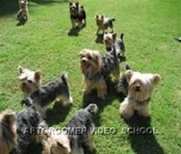 |
Curly Coated Retreiver
Other Names: Curly Coat, Curly Country of origin: Great Britain Dog Group Kennel Club: Sporting General appearance: The coat of the Curly Coated Retriever is unique and distinctive. The coat on the body is a mass of thick tight, small curls that lay close to the skin. The coat on the feet, face, and forehead is smooth, short, and straight. The coat is water and weather resistant. The Curly Coated Retriever breed is an average shedder. One of the largest of the Gundog group, they are strong, upstanding dogs who portrait an air of elegance, and effortlessly cover the ground with extension and good drive. Curly's are medium to large sized dogs, the size of any Labrador retriever, with a muscular body and strong fore and hind limbs. They have deep chests, long tails and big hearts. Curly-Coated Retrievers have an excellent nose and a good memory. Bred for retrieving quail and waterfowl, they are superb swimmers with great stamina and they know how to carry dead or wounded animals gently in their mouth. Colours: Solid black or solid liver.
Bitch 64cm (25") 64cm (25") Dog 69cm (27") 69cm (27") Weight: Bitch 33kg (73lbs) 33kg (73lbs) Dog 40kg (88lbs) 40kg (88lbs) Temperament: Bold, friendly, self confident dogs who may appear aloof with strangers but will give years of loyalty and devotion to the immediate family. They are reasonably patient with children and will get along with other dogs and household animals. They are very energetic and playful, but are also adaptable and adjust to their owner's mood. The Curly-Coated Retriever is better at guarding than other retrievers, and is generally a very good obedience dog. They can be scrappy when in the field with other dogs, but are very trainable. Movement: Effortless, powerful gait with good extension and drive. Parallel movement. At speed, legs tend to converge. Care and training: Never use a brush or a comb on a Curly as this will flatten the curls. They do cast: dogs once a year, bitches after their seasons and it is at this time that a bath should be given to get rid of the dead hair; thereafter wetting them once a week will encourage loose hair to drop off and tighten the curls. If the coat becomes too long, it can be trimmed with straight scissors. The Curly Coated Retriever breed is sensitive, independent, and has a tendency to be stubborn. Early socialization and obedience training is crucial. It is important that training sessions be short and varied as they become bored quite easily. Curly Coated Retriever's do not respond to harsh or heavy-handed methods. Training must be done with firmness, fairness, and consistency. However, they do have minds of their own and therefore training must be a challenge and varied to keep them becoming bored and losing interest. Overall Exercise:40 - 60 minutes per day. Feeding requirements: Depends on the type and quality of food used. Care must be taken to avoid the possibility of Gastric Torsion (Bloat) which Curlies (like all large and deep chested dogs) are susceptible to. Exercise: High Grooming: Med Noise: Low Personal Protection: Medium Suitability As Guard Dog: Low Level of Aggression: Low Compatibility With Other Animals: High Suitablity for Children: Medium Often docked? No Average litter: 7 - 8 Life expectancy (yrs): 8 - 14 History: A cross between the Newfoundland, the English Water Spaniel, the Irish Water Spaniel, and the Poodle, the Curly Coated Retriever's roots go back into the 1800s of British history. It is the oldest known retriever that has come from Britain. The exact origins of the breed are not well documented, however it is known that the breed was frequently used for retrieving waterfowl and other hunting game in England. Later when it was imported into Australia and New Zealand the breed became very useful and well-known.
|
|
|
|
